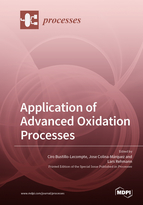Application of Advanced Oxidation Processes
A special issue of Processes (ISSN 2227-9717). This special issue belongs to the section "Environmental and Green Processes".
Deadline for manuscript submissions: closed (31 March 2020) | Viewed by 51674
Special Issue Editors
Interests: advanced treatment of water and wastewater; waste minimization and water reuse; integration of advanced oxidation technologies and biological processes for industrial wastewater treatment; water, soil, and air quality; energy and resource recovery
Special Issues, Collections and Topics in MDPI journals
Interests: heterogeneous catalysis; thin films and nanotechnology; chemical reaction engineering; adsorption; industrial wastewater treatment by solar photocatalysis; novel material synthesis for advanced oxidation processes applications
Special Issues, Collections and Topics in MDPI journals
Interests: application of advanced oxidation processes; biomass pretreatment; bioassay development for emerging contaminants; quantification of genotoxicity and estrogenicity of micro-pollutants
Special Issues, Collections and Topics in MDPI journals
Special Issue Information
Dear Colleagues,
The increasingly stricter standards for effluent discharge and the decreasing availability of freshwater resources worldwide have made the development of advanced wastewater treatment technologies necessary. Advanced oxidation processes (AOPs) are becoming an attractive alternative and a complementary treatment option to conventional methods. AOPs are used to improve the biodegradability of wastewaters containing non-biodegradable organics. Besides, AOPs may inactivate pathogenic microorganisms without adding additional chemicals to the water during disinfection, avoiding the formation of hazardous by-products. This Special Issue of Processes aims at covering recent progress and novel trends in the field of AOPs, including UV/H2O2, O3, sulphate-radical oxidation, nanotechnology in AOPs, heterogeneous photocatalysis, sonolysis, Fenton, photo-Fenton, electrochemical oxidation, and related oxidation processes. Topics to be addressed in this Special Issue of Processes may also include the application of AOPs at various scales (laboratory, pilot, or industrial scale), the degradation of emerging contaminants in water and wastewater and pollutants in the gas phase, the quantification of toxicicy in residuals, the development of novel catalytic material and of hybrid processes, including the combination of AOPs with other technologies, process intensification, and the use of photo-electrochemical processes for energy production. Authors with expertise in these topics are invited to submit their original manuscripts and review articles to Processes.
Dr. Ciro Bustillo-Lecompte
Dr. Jose Colina-Márquez
Dr. Lars Rehmann
Guest Editors
Manuscript Submission Information
Manuscripts should be submitted online at www.mdpi.com by registering and logging in to this website. Once you are registered, click here to go to the submission form. Manuscripts can be submitted until the deadline. All submissions that pass pre-check are peer-reviewed. Accepted papers will be published continuously in the journal (as soon as accepted) and will be listed together on the special issue website. Research articles, review articles as well as short communications are invited. For planned papers, a title and short abstract (about 100 words) can be sent to the Editorial Office for announcement on this website.
Submitted manuscripts should not have been published previously, nor be under consideration for publication elsewhere (except conference proceedings papers). All manuscripts are thoroughly refereed through a single-blind peer-review process. A guide for authors and other relevant information for submission of manuscripts is available on the Instructions for Authors page. Processes is an international peer-reviewed open access monthly journal published by MDPI.
Please visit the Instructions for Authors page before submitting a manuscript. The Article Processing Charge (APC) for publication in this open access journal is 2400 CHF (Swiss Francs). Submitted papers should be well formatted and use good English. Authors may use MDPI's English editing service prior to publication or during author revisions.
Keywords
- Advanced oxidation processes (AOPs)
- Water and wastewater treatment
- Hybrid processes
- Process intensification
- Heterogeneous photocatalysis
- Fenton
- Sulphate-radical oxidation
- Advanced electrochemical oxidation
- Sonolysis
- Energy production








